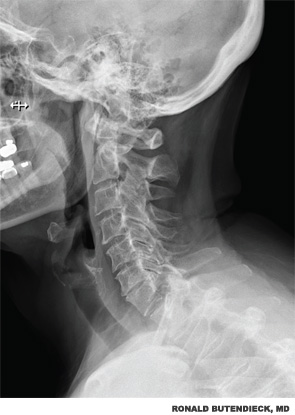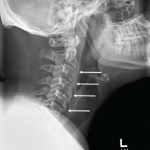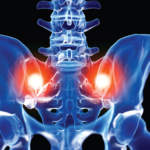The patient also reported significant chronic neck pain with radicular symptoms that began after a fall in 1987. She was referred to a physiatrist and noted to have previously undetected DDD. Treatment included acetaminophen, nonsteroidal antiinflammatory drugs (NSAIDs), physical therapy, massage and relaxation training. Evaluation revealed diffuse weakness in her upper extremities, significant scapulothoracic dyskinesia with decreased range of motion and impingement of both shoulders, and reduction in lateral rotation of the cervical spine. She also had cervical facet discomfort. Reflexes were globally diminished. Radiographs of cervical spine noted DDD with multilevel facet arthrosis, but no subluxation at C1–C2 (see Figure 2, right). An MRI of the cervical spine did not demonstrate significant spinal stenosis or compressive lesions.

Electromyography did not demonstrate a cervical radiculopathy. Radiographs of the shoulders revealed acromioclavicular joint degenerative changes, marked glenohumeral joint space narrowing, and osteophyte formation with remodeling of the undersurface of the acromion bilaterally compatible with chronic rotator cuff arthropathy.
Fluoroscopically guided C7–T1 interlaminar epidural steroid injection was successful in alleviating her symptoms. The treatment plan combined physical therapy (PT) and occupational therapy (OT).
Discussion
RA and OA are both well-recognized clinical disease entities. This patient had both active erosive RA and untreated OA, contributing to her pain, decreased range of motion, weakness and reduction in QOL. She was assessed for both conditions, and a plan of care addressing each of these processes was put into action.
Conclusion
Multidisciplinary assessment and discussion among the rheumatologist, physiatrist, physical therapist, occupational therapist and the patient led to treatments for both RA and DDD, relieving years of unnecessary pain. Combination therapy with abatacept, hydroxychloroquine, acetaminophen, localized corticosteroid epidural injection, PT and OT enhanced her QOL.
In patients with RA, evaluation for other contributing causes for pain should be undertaken, especially for underlying OA. Early concomitant assessment and treatment of RA and OA may lead to better patient outcomes and QOL.
Patients who read and research information available to the general public from such sources as the ACR, Mayo Clinic brochures, Johns Hopkins brochures and white papers, and the Arthritis Foundation’s website can identify potential causes for their pain and enhance collaborative discussions with their clinical care physicians.
Patricia Frisch, PhD, LPC, LLC, is the corresponding author, an independent researcher, and retired director and owner of the Clinical and Pastoral Counseling Center and Allied Health Professional at Roper St. Francis Hospital in Charleston, S.C.


